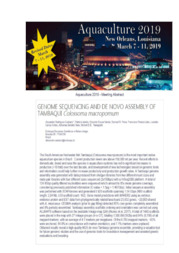Genome sequencing and de novo assembly of tambaqui (Colossoma macropomum).
Genome sequencing and de novo assembly of tambaqui (Colossoma macropomum).
Author(s): CAETANO, A. R.; IANELLA, P.; VARELA, E. S.; PAIVA, S. R.; LOBO, F. P.; CINTRA, L. C.; ZERLOTINI NETO, A.; YAMAGISHI, M. E. B.
Summary: The South American freshwater fish Tambaqui (Colossoma macropomum) is the most important native aquaculture species in Brazil. Current production levels are above 150,000 mt per year. Recent efforts to domesticate, breed and raise the species in aquaculture systems has led to significant increases in production (>10-fold) over the last decade, and development of new technologies based on genomic tools and information could help further increase productivity and production growth rates.
Publication year: 2019
Types of publication: Abstract in annals or event proceedings
Keywords: Bioinformatics, Colossoma Macropomum, Fish, Genome assembly, Tambaqui
Observation
Some of Embrapa's publications are published as ePub files. To read them, use or download one of the following free software options to your computer or mobile device. Android: Google Play Books; IOS: iBooks; Windows and Linux: Calibre.
Access other publications
Access the Agricultural Research Database (BDPA) to consult Embrapa's full library collection and records.
Visit Embrapa Bookstore to purchase books and other publications sold by Embrapa.

